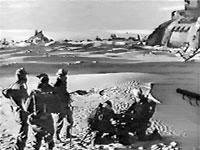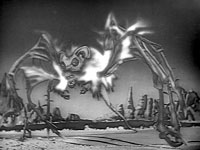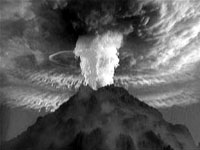PARALLAX REVIEWS:
Mars Movies: Little Green Men from a Red Planet
For Space.com


In 1877, astronomer Giovanni Sciaparelli observed what he considered to be "canali" (or channels), criss-crossing the surface of Mars. Due to their transient nature (photographs of Mars didn't reveal them; only astronomers were purportedly able to see these channels) and some language confusion (the Italian word "canali" translated as "canals", or trenches possibly dug by intelligent life), humans started serious speculation about life on Mars. Subsequent close-surface mappings by the Mariner and Viking spacecrafts showed a lack of artificially-created canals, but it was too late; the Martian invasion of our psyche had begun.
From the early beginnings, Martians were presumed to be smarter and more technologically advanced than humans, despite their anti-social penchant to invade our planet and kill us. The "canals" were hypothesized to be a planet-wide means of irrigating the desert areas from the polar ice caps, surely the last desperate signs of an intelligent, dying race. It stands to reason that Martians would be primarily male and undoubtedly aggressive; the planet takes its name from the Roman god of war, due to the blood-red iron oxide heavy on it's surface. In keeping with Greek tradition, Mars' two sons, Phobos (Greek for "Fear") and Deimos ("Terror") orbit the planet as small satellites.
Undeniably one of the first contributions to Martian fiction was H.G. Wells' War of the Worlds, published in 1897. Broadcast by Orson Wells in 1938 and released as a film in 1953, War of the Worlds dealt with a near-successful invasion by Martians, where humanity's saving grace was the lousy immune system of the Martians. Edgar Rice Burroughs and Ray Bradbury furthered tales of Martian civilizations in literature, and Rocketship X-M (1950) landed on Mars to a once advanced, but now-regressed race. The Red Planet Mars (1952) delivered a purported message to Earth to obliterate Communism, and Martians invaded our planet again in Invaders from Mars (1953). Even Abbot and Costello (Abbot and Costello Go To Mars, 1953) attempted to reach Mars, only to be sidetracked by Venus.
In the interplanetary exploration film, It! The Terror from Beyond Space (1958), humans set their silver cigar-shaped spaceship down on Mars by the ambitious year of 1973. The first crew was destroyed by one of those suspicious nameless horrors (see Forbidden Planet) that spares only one survivor. In this case, the sole survivor, Colonial Carruthers (Marshall Thompson) is promptly whisked aboard the rescue ship to return to Earth and stand trial for the death of his crew. During the four-month voyage back, members of the second crew disappear, only to be found later stuffed in the air ducts with "every ounce of edible fluid" in their bodies gone (It! was the precursor to Alien). As it turns out, there's a hungry Martian aboard the ship, and the really bad news is that conventional weapons and nuclear blasts have no effect. Fortunately, in one of those alarmingly convenient happenstances, the Martian has acquired a taste for oxygen and is eventually killed by popping opening the ship's airlock and asphyxiating it. Only four of the crew survives the final attack, which almost seems like four too many.
Spidery, bat-like Martians obliterate human crews once again in The Angry Red Planet (1959), and eventually conquer the humans in The Day Mars Invaded Earth (1962). Revenge is a dish best served cold, and we retaliate by sending Santa Claus over to conquer Martian tyke Pia Zadora in Santa Claus Conquers the Martians (1964). Crash-landing on Mars, the stranded Robinson Crusoe on Mars (1964) conveniently discovers of oxygen-bearing rocks that allow him to survive. Martians have other needs too and Mars Needs Women (1966), specifically our Batgirl, Yvonne Craig. The Martians attack us once again in Mission Mars (1968), turning one of our Russian comrades into a space popsicle. Nearly a decade later, Elliot Gould and O.J. Simpson fake a trip to Mars in Capricorn One (1978), firing up the conspiracy engines.
Ray Bradbury's popular 1951 book, The Martian Chronicles (a.k.a. The Silver Locusts) finally reached TV in 1985. Here, the Martians were certainly more advanced, and, in some cases, more likable than the humans. In Red Planet, the Martians lull the first explorers of Mars into a false sense of security by replicating dead loved ones, to devious ends. The Concrete Mixer deals with a tongue-in-cheek Martian invasion thwarted by overly-friendly Earthlings, and The Martian deals with a doomed human-replicate who replicates one many sad human memories. The Earthmen are the second explorers of Mars, and are promptly thrown in an insane asylum and later executed by the Martians by reason of insanity. And the Moon Be Still As Bright is the final mission to a now-dead Mars, obliterated by chicken pox. One of the crew empathizes with the dead Martians and kills the rest of his crew, who is busy destroying Martian artifacts.


"It's dry, it's ugly, it's boring", speaks Sharon Stone in Total Recall (1990). Nope, she's not talking about her pseudo-husband Douglas Quaid (Arnold Schwarzennager), she's talking about Mars. And she has justifiable reason to complain - Quaid, who's a bad guy convinced he's a good guy who ends up being a good guy, kills her on Mars. Mars isn't such great place if you're a hooker or a terminium ore-miner either; power-hungry Cohaagen (Victor Cox) has been a tad stingy with the oxygen in the past, leading to horribly disfiguring genetic mutations. This means triple-breasted hookers in Venusville, which undoubtedly garners a nod of approval from the planet's namesake. The evil-doer Cohaagen eventually stops all oxygen on the planet, but all is not lost for the plucky, sleazy inhabitants; eons ago, the self-sacrificing Martians built a core reactor to completely obliterate their own natural atmosphere and replace it with Earth's atmosphere. Talk about a self-sacrificing alien race with far too much time and technology on their hands. Cohaagen tries to hide the reactor, but Quaid finds it and fires it up anyway, introducing blue skies to the red planet.
On a more elemental note, Mars Attacks! (1996) contradicts the noble Martians in Total Recall and confirms everything we previously suspected: those little green men from the red planet are just plain evil. "Ack-ack ack-ack" ("We come in peace"), proclaim the nasty little buggers mere seconds before vaporizing us and destroying our national monuments. Worse still, they appear to be having a lot of fun doing it. Our final saving grace is that the evil invaders can't stand Slim Whitman's yodeling (perhaps another sign of an advanced civilization) and their oversized heads explode in a juicy mess inside their space helmets. Yet another narrowly averted Martian invasion.
The fascination with life on Mars continues, often times blurring that fine line between fact and fiction. Surface structures such as the pyramid-shaped mountains in the Elysium high plateau and the eventually indistinguishable stone face at Cydonia have their share of "intelligent life on Mars" supporters, undoubtedly fueled by Martians in science fiction. There was a brief spark of scientific excitement over Gibson and McKay's Antarctic meteor, ALH840001, that contained tiny, bacteria-like structures possibly from Mars. For although Mars may be circled by Fear and Terror, it seems to be our best (and closest) interplanetary hope for uncovering our own origins. And that's an intriguing prospect.
Links Away:
- Streaming: Mars Needs Women
- Streaming: Rocketship X-M
- Streaming: Angry Red Planet
- Streaming: Total Recall